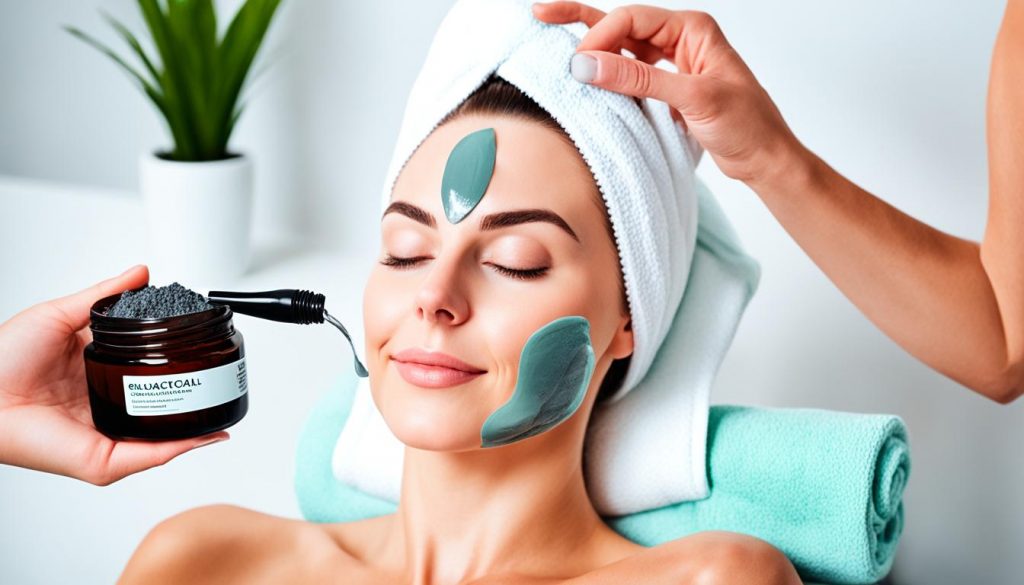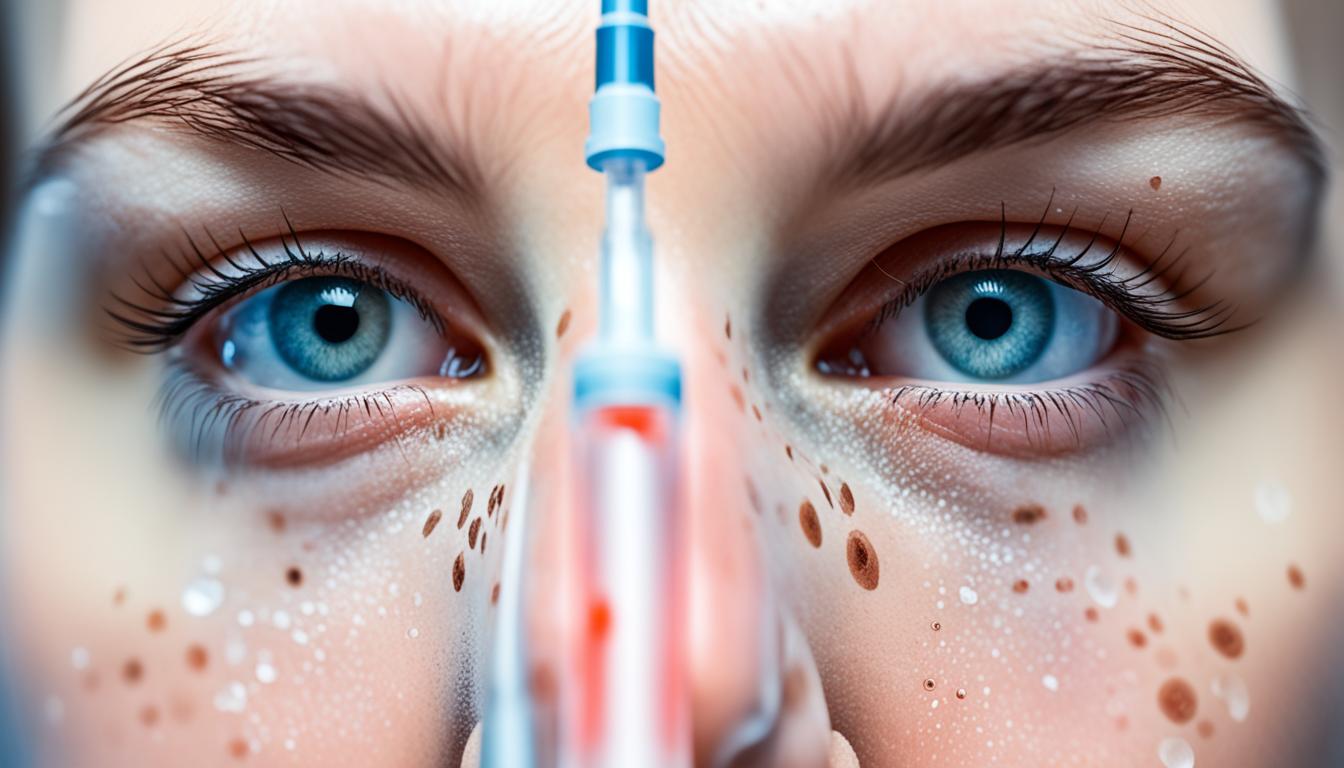Blackheads are a common issue for people of all ages. These black bumps appear when oil and dead skin clog the pores. Though not harmful, they can lower self-esteem and confidence. This article will cover the symptoms and causes of blackheads. It will also discuss their diagnosis and the use of stem cell therapy for treatment.
Key Takeaways:
- Blackheads are small black bumps on the skin caused by clogged pores and excess oil.
- A consistent skincare routine is crucial in managing and preventing blackheads.
- Dermatologists can diagnose blackheads based on their appearance and may recommend professional treatments for severe cases.
- Stem cell therapy shows promise in reducing inflammation and promoting skin regeneration for blackheads.
- Early intervention and proper skincare can help minimize the occurrence of blackheads and improve self-esteem.
Understanding Blackheads and Acne
Blackheads are a type of acne that appear as tiny black bumps on the skin. They’re found mainly on the face, especially in the T-zone. This includes the forehead, nose, and chin. They can also show up on the chest, back, and shoulders. People with oily skin tend to get blackheads more because they produce more sebum.
Blackheads can often be kept under control with a good skincare routine and over-the-counter products. However, severe cases might need a dermatologist’s help. Unlike other types of acne, like whiteheads or pimples, blackheads have their own unique traits.
Characteristics of Blackheads
Blackheads, or open comedones, have a dark look because of the way they form. This dark color isn’t dirt but is due to melanin oxidation. Melanin is what gives our skin its color. When pores get clogged with oil and dead skin cells, and hit by air, the melanin darkens. That’s how blackheads are born.
Whiteheads are different because they’re covered and don’t get exposed to air. On the other hand, blackheads have an open surface. This allows air to oxidize the melanin, turning it black.
Managing Blackheads
Keeping blackheads at bay calls for a solid skincare routine. This means washing your face twice daily with a gentle cleanser. You should also exfoliate to keep dead skin off your pores. Using products with salicylic acid or benzoyl peroxide can also help clear the pores and reduce blackheads.
If you have oily skin or stubborn blackheads, you might want to see a dermatologist. They can tailor a skincare plan for you or prescribe treatments. These could be topical retinoids or professional services like chemical peels or microdermabrasion.
Preventing Blackheads
To prevent blackheads, start with a steady skincare regime. Choose products that won’t clog pores and exfoliate regularly. Avoid scrubbing your face too hard or picking at it, as this can make things worse.
Managing oil with absorbing sheets or tweaking your diet can also fend off blackheads. It’s key to keep a healthy lifestyle with a balanced diet, plenty of water, and stress control. This promotes overall skin health.
| Differences Between Blackheads, Whiteheads, and Pimples | ||
|---|---|---|
| Blackheads | Whiteheads | Pimples |
| Open comedones | Closed comedones | Inflamed, pus-filled lesions |
| Form when pores are clogged with excess oil and dead skin cells | Form when pores are clogged with oil and dead skin cells but have a closed opening | Form when bacteria infects clogged pores, causing inflammation and the formation of pus |
| Appear as small black bumps on the skin’s surface | Appear as small white or flesh-colored bumps | Can be red, swollen, and painful |
| Exposure to air causes oxidation of melanin, resulting in a dark color | Since the opening is closed, they do not darken | Pus-filled, can appear as red bumps or have a white or yellow center |
Causes and Risk Factors for Blackheads
We don’t fully understand why blackheads form. However, certain factors seem to play a big part. Knowing what causes blackheads can help us manage and prevent them better.
Hormonal Changes
Hormones can go wild during puberty or menstrual cycles, causing more sebum. Sebum is an oily stuff our skin makes. Too much of it can clog pores and lead to blackheads. People of any gender and age can experience these hormonal shifts.
Diet and Lifestyle
Your diet doesn’t cause blackheads directly. But, eating lots of sugary foods can mess with your insulin. This might make your skin produce more sebum, which can cause blackheads. Also, not eating healthy food can make your skin worse and blackheads more likely.
Excessive Sebum Production
If you have oily skin, you might see more blackheads. This skin type means your sebum levels are naturally high. More sebum means more chances for dirt and dead skin to block your pores and form blackheads. Managing oily skin with the right skincare is key.
Stress and Medications
Stress isn’t just tough on your mind; it can also affect your skin. It can lead to more sebum, making blackheads more likely. Also, some medications, like corticosteroids, can increase sebum and make blackheads worse.
Prevention and Management
To fend off blackheads, tackle the root issues and take care of your skin. Clean your face regularly to get rid of oil, dead cells, and dirt. Gentle scrubbing can open up clogged pores. Eating right and managing stress helps too.
If blackheads keep popping up, seeing a skin doctor might be a good idea. They can suggest the best care routine or treatments for your skin type. This can help keep your skin clear and healthy.
Knowing why blackheads happen lets us fight back better. Taking action early can help keep our skin looking good.
Diagnosis and Treatment Options for Blackheads
Blackheads are a common skin issue for people of all ages. They are small, dark spots that appear when pores get clogged. This clogging is due to too much oil and dead skin cells. Sometimes, dermatologists might use a special tool, a comedone extractor, for a closer look.
To fight blackheads, it’s key to have a good skincare routine. This includes washing your face gently to remove dirt and oil. It’s also important to exfoliate regularly to clear out dead skin and keep pores open. Using products with salicylic acid or benzoyl peroxide can help clean your pores and manage blackheads.
Over-the-counter options with these ingredients can reduce blackheads and prevent new ones. Salicylic acid cleans and exfoliates the skin. Benzoyl peroxide kills bacteria and eases inflammation.
If blackheads don’t go away or if there’s other acne, seeing a dermatologist is a smart move. They can suggest treatments like chemical peels or microdermabrasion. These procedures renew skin cells and improve your skin’s look.

Skincare Routine for Treating and Preventing Blackheads
To keep blackheads at bay, a consistent skincare routine is essential. Here are basic steps to follow:
- Gentle Facial Cleansing: Wash your face twice a day with a gentle, acne-fighting cleanser. Look for ingredients like salicylic acid or tea tree oil, which help clear pores.
- Exfoliation: Exfoliate gently once or twice a week to get rid of dead skin and unclog pores. But be gentle to avoid irritating your skin.
- Pore-Cleansing Products: Use products made to fight blackheads and reduce large pores. Clay or charcoal are great for absorbing excess oil and dirt.
- Oil-Free Moisturizer: Pick a light moisturizer that won’t clog pores to keep your skin hydrated.
- Sun Protection: Use sunscreen with at least SPF 30 daily to protect skin from the sun’s harmful rays, which can make blackheads worse.
Sticking to a good skincare routine and healthy living can help manage blackheads. If problems persist, see a dermatologist for specialized advice and treatments.
Comparison of Blackhead Treatment Options
| Treatment | Description | Effectiveness | Cost |
|---|---|---|---|
| Over-the-counter treatments | Includes creams, gels, or cleansers with salicylic acid or benzoyl peroxide. | Good for mild to moderate blackheads. | Affordable |
| Professional treatments | Dermatologists perform treatments like chemical peels or microdermabrasion. | Better for tough blackheads. | More expensive |
| Stem cell therapy | An innovative option that helps skin regenerate and calms inflammation. | Shows promise but still under study. | Prices vary; hard to find |
Stem Cell Therapy for Blackheads – A Promising Treatment Approach
Recent studies suggest stem cell therapy could be key in treating blackheads. Stem cells can turn into various skin cells. This ability might change how we tackle common skin problems. Through fixing damaged skin cells, stem cell therapy can greatly uplift the skin’s look and health when blackheads are a problem.
When it comes to blackheads, stem cell therapy offers several advantages. It first helps lessen inflammation, which is crucial in blackhead development. Next, it adjusts how much sebum the skin produces, targeting blackheads’ main cause. Stem cell therapy also encourages the skin to renew itself, making it look and feel better. This new treatment might greatly help those struggling with tough or bad blackheads, improving how they see themselves.
Although using stem cells to fight blackheads is still pretty new, it’s a promising direction. It could change future acne treatments, giving people a new way to make their skin regenerate and tackle blackheads from the root. As more studies and improvements happen, stem cell therapy might become a main option for treating acne.

